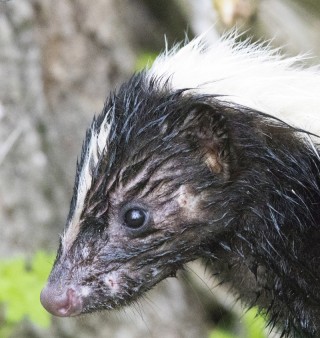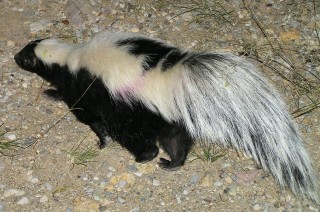
This busy “Pepé Le Pew” was rooting around in the morning dew-wetted wild flowers of northern Bee County this spring. Robert Benson Photo.
04/18/2015 – Something Stinky This Way Comes
Have you ever seen a skunk foraging? It ambles about checking the ground for insects, small animals and even carrion. It quickly chomps down on anything edible it finds, and then ambles on. Seen like this it seems a peaceable animal.
But its bold black and white patterning is a warning: I’ve got a powerful defense mechanism, so go away and leave me alone! Most predators and competitors do just that.
If, however, the intruder persists, the skunk gives another more obvious warning. It stamps its front feet, arches its back, and lifts its tail. It aims the twin glands next to its anus, and if the intruder hasn’t left quickly, sprays a foul-smelling, acrid liquid. This “skunk musk” is so stinky, it will deter even the hungriest of predators.
Still, skunks are a regular part of the diet of Great Horned Owls. Maybe an aerial attack doesn’t give the skunk time to deploy its weapons. More likely, owls don’t have a great sense of smell. In any case, Great Horned Owls and their nests often have a lingering odor.

There are five species of skunks in Texas. The most common is the Striped Skunk. You may recognize it by a white stripe down its face and a wide, white “V” on its back. Or you can recognize it by its skunky fragrance! Striped Skunks are the skunks most likely to be out foraging at dawn or dusk, even though they are primarily nocturnal. They are inhabitants of brushy or wooded areas and associated with farms and ranches. Wikimedia Commons Photo.
There are five species of skunks. The most common is the Striped Skunk. It is recognized by a white stripe down its face and a wide, white “V” down its back. Striped Skunks are the most likely to be out foraging at dawn or dusk, even though they are primarily nocturnal. They are inhabitants of brushy or wooded areas and their associated farms and ranches. Since they are not very choosy in their food habits, they often seek out carrion along roadsides, and unfortunately become roadkill themselves.
Eastern Spotted Skunks have a small white spot on their foreheads and one by each ear. They are smaller and more slender than the Striped Skunks. Their favored habitats are wooded areas and tall-grass prairies, but they have a tendency to live around farmyards. Since they weigh only about two pounds, they are rather cute and people have been known to keep them as pets (after having been de-scented, of course.) These skunks have the habit of standing on their heads and aiming their musk ducts at anyone threatening them. Can you imagine how charming a little head-standing animal might be? Unless, it hadn’t been “de-skunked” that is. Then its charm would quickly turn to disgust.
Western Spotted Skunks occur in the western part of Texas. They are associated with “rocky bluffs, cliffs and brush-bordered canyon streams” and with rock fences. Rock fences serve as refuges for many kinds of animals on which the skunks feed. Hollows in the fences make good denning sites for the skunks as well. Western Spotted Skunks, like the Eastern species, make very good mousers and can readily rid a barn of rats. However, both species can do considerable damage to poultry operations once they get a taste for eggs.
Hog-nosed Skunks have a naked pad on their snouts. This sensitive area is about an inch square and allows the skunk to root around in the ground for its food. Patches of ground that appear to have been plowed up by a small pig are sure sign that a Hog-nosed Skunk has worked the area. This foraging behavior has earned them the name “rooter skunks” in many parts of Texas.
Hooded Skunks are closely related to Striped Skunks and look very much like them. However, this species is much smaller and slenderer than its striped cousin. They have longer, finer fur with a distinct ruff of longer hair on the backs of their necks. Hooded Skunks are primarily a Mexican species but are known from the Big Bend area of Texas.
What exactly is the stink of a skunk made of? I found out that it is a mixture of two chemicals, called thiols, which are similar to the sulfurous compounds in garlic and onions. In tiny amounts, these thiols actually smell rather pleasant. To me, a faint skunk smell reminds me of the smell of coffee (which is probably why I prefer to drink tea!) But the spray in its concentrated form (which is how it is ejected from the skunk’s glands) is a nauseating, head-wrenching, eye-stinging AWFUL!
The powerful stink is hard to get rid of, too. It is best just to discard clothing that has been sprayed. But what do you do if you, or your dog, have been sprayed? The Humane Society recommends bathing a skunked dog in a bath of dishwashing liquid, hydrogen peroxide, and baking soda. These ingredients need to be mixed up fresh in order to be effective. I guess the same solution would work on a human.
Once, I came close to having to try it out. Before we built our house, we liked to watch the sunset from our pasture. As we sat on our camp stools and watched the sun sink slowly in the west, a skunk wandered by. It was foraging and did not see us. It ambled right next to my leg (I could have touched it if I hadn’t been frozen with fascination…or fear!) but it still did not detect us. Suddenly, the camp stool creaked and the skunk freaked out. I thought for a moment it was going to spray us. Instead, it stopped walking, got up on its tiptoes with all four feet close together, and “bounced” off into the brush. Do you remember the cartoon character “Pepé Le Pew”, the flower-loving skunk? That is exactly how this skunk moved.
But don’t count on a skunk bouncing away on his tiptoes. If he raises his tail, does a headstand, or just turns his back on you, RUN FOR IT!
If you would like to offer comments, please click through to the discussion page
